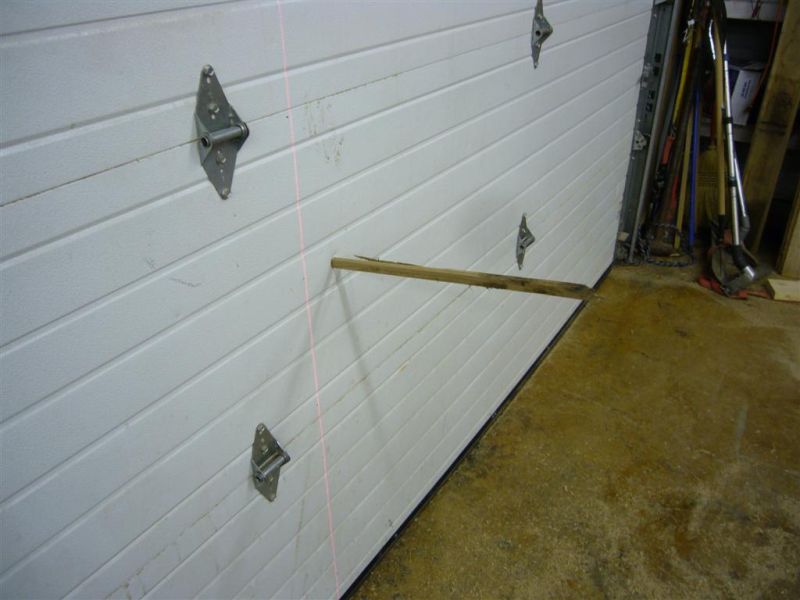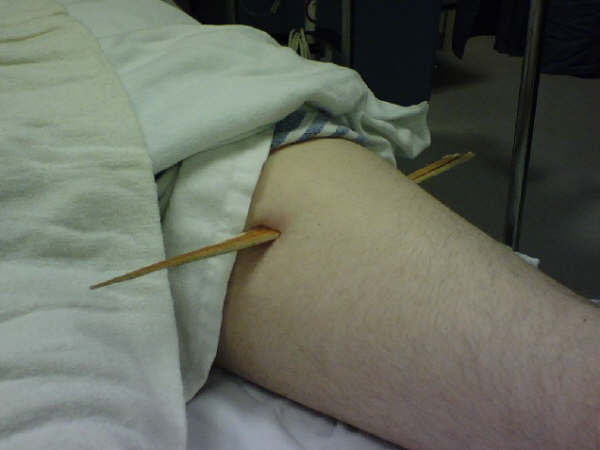Question
We have had two very bad kickback situations in the last few months where the wood piece was thrown back at the operator and actually pierced the door in front of the ripsaw. The anti kickback fingers are adjusted properly as far as we can tell. Is there any kind of vest or belt the operator could wear to protect against getting skewered? I have looked extensively online and am striking out. I do not want to watch one of our guys bleed to death due to getting impaled.

Forum Responses
(Dust Collection and Safety Equipment Forum)
From contributor F:
Don't know about the vest idea, but the first rule of thumb is never, repeat never stand behind a board as it's being ripped. Always standto the side and if a kickback does happen there will be no injury. Having said that it sounds like there is something not adjusted correctly on your machine. I've run a lot of stock through SLR saws and have never had, or seen anyone else have a kickback.
We recently bought a used Diehl SL55, and it was shipped with a heavy leather apron. This apron was doubled over, two ply thick leather in the 'combat zone'. Seemed to be a good idea since the kickback fingers were all bent and hung up. We repaired the fingers and have had no kicks, and no need for the vest. A good brake is also helpful, since most kicks hang up and sing before they shoot back. Hitting the brake avoids the 'stand aside and wait for it to shoot' behavior.
It is wise to position the saw so that visitors or benches are not in the line of potential fire. Pipe rails or solid guards can also help control where people may be. One shop I saw had heavy plastic curtains 16' behind the saw to catch/deflect. Operator placement is crucial. Lumber, operator and scrap or other carts need to be set such that the operator has to intentionally move into the danger zone, not stand there as routine.
Always stand to the left of the blade (assuming the fence is on the right) and follow all the way through with your right arm till you clear the cutting motion. This may seem like basic ripping 101, but you'd be surprised how many "seasoned" pro's do it wrong. In one of my old shops we used to have a backer board behind the saw operator to protect anybody in the background.
Also be careful when ripping bevels, I once got hit with cut-off piece cutting a 45 on a small panel. I did everything right, stood on the left, etc. It was a very strange incident, my only guess is that the blade was worn and blunt and the piece got wedged between the blade and the table or throat plate. It probably didn't help that the piece was short in length either. Anyhow getting hit with a cut-off (which is extremely rare) or getting hit with the "ripped" stock is the difference between being bruised or becoming a shish kabob.
I have been hit a couple of times because the dummy does not and refuses to use the anti kickback. So I bought a welders leather apron. I then cut the front cover off a 1/4" plastic notebook binder and used rivots to attach it to the apron belly high. It does not prevent kickbacks, however it does prevent bruises or being skewered.

Itís hard to get a kickback if there isnít anything to kick back in the first place. Iím sure that small slivers can exist when ripping very short pieces that the tailboy canít get, but if itís typical moulding blanks, it should not be an issue at all. Iíve run an old SLR for 12 years with no kickbacks, knock on wood. The most important thing I teach the tail guy is to get the scrap out of the way first.
I've been a cabinetmaking instructor for 15 years and during that time we have had only three kickbacks from the table saw. The cause of all three was the same - the operator let the material get away from the rip fence and contact the back of the sawblade. As dangerous as kickbacks are, they are easily prevented with a little safety education.
1. If you don't have feed rollers, make sure the material remains in contact with the rip fence for the entire cut.
2. Push the entire length of the material past the blade.
3. Make sure your blades are sharp to avoid material uplift.
4. Don't let any cut off pieces become wedged between the blade and the safety guard.
5. Your focus when ripping should be on the rip fence...not the blade.
I have operated two different gang rips and two different single blade straight line rips. The machine I got hurt off of was brand new, only in service for a little over a year. The machine was cleared by the manufacture and OSHA. I was not standing directly behind the saw, I was to the left of the saw when I was hit. A ripping ( a little over 1/2 inch wide and about a 1 inch tall, about 8 foot long), came out of the saw and hit me in the chest just below the left nipple and exited below the sixth rip on my back - yes you heard my right, it went through me. I was life flighted to the hospital and so far am making a good recovery. Like I said I am not sure what would have stopped it and still allowed you to work while wearing it. I would highly recommend wearing a safety vest.
The saw was an old 5 hp Rockwell that my boss had us drag into the building for the duration of the project. Between the high moisture content of the treated lumber and the suspect nature of the aftermarket splitter and paws I was an accident waiting to happen. After about six hours of constant ripping I started zoning out and got a little inattentive. The result was a 16' long pine spear that shot through a 3/4" SYP plywood window covering and out into the street. Thankfully no one was injured but the potential for catastrophe was certainly present. That was 20 years ago and ever since I have always been vigilant about where I stand. I also use hold downs, splitters and guides that keep the material firmly in contact with the fence on the out feed side of the blade.
I would spend some serious time checking the set up on your saw. Run out on the blade with a dial indicator, check for any wobble from worn bearings, etc. One thing that I have seen become an issue in shops that use auxiliary fences in particular is that the face of the fence will wear, especially in the area perpendicular to the blade itself. This dishing out of the fence face may not be very apparent but where I work now we cut a lot of laminated panels and the wear on the fence faces is quite serious and rapid. Periodically check to make certain that the face of the fence is dead flat end to end and that there's nothing on the outfeed side of the blade that can redirect the material. Better to find the cause and cure it rather than wear a flak vest to treat the symptom.
Comment from contributor H:
A kickback occurs when the kinetic energy of the blade is transferred to a projectile. This can only happen if the blade and projectile become one in the sense that the teeth engage the wood (i.e. no longer cutting correctly). Most often, this occurs when the projectile rides up on the blade and allows the teeth to dig into the projectile thereby transferring energy.
The best way to prevent this is to prevent the work item from moving upwards as it moves through the saw. Correctly adjusted kick back pawls help here as do correctly set up SLR machines. If youíre using a conventional saw as an SLR, consider installing a feeder. Just remember, a spit second of releasing that downward pressure on the work item could see your work item become a projectile!
One of the biggest reasons for these fingers to be damaged is the condition of the center strips in the feed chain. These are usually supplied with rubber strips from the manufacturer and allow the saw blade to extend through the wood without hitting the metal of the feed chain. If these rubber strips become worn or damaged, thin strips or cracked pieces of wood can get trapped and pinched by the blade causing a kickback. They need to be inspected and replaced regularly.
Saws usually come with logical directions about feeding warped or cracked wood. If these directions are ignored you will triple your chance of encountering a kickback. There are also hidden cracks and loose knots that no one can anticipate which is why maintaining the fingers and rubber strips is so important. Not to mention plain old human error.
The majority of our tablesaw kickback accidents have to do with the operator not using the guard, not pushing the wood part all the way clear of the blade, or dropping the part on the moving blade after the cut.